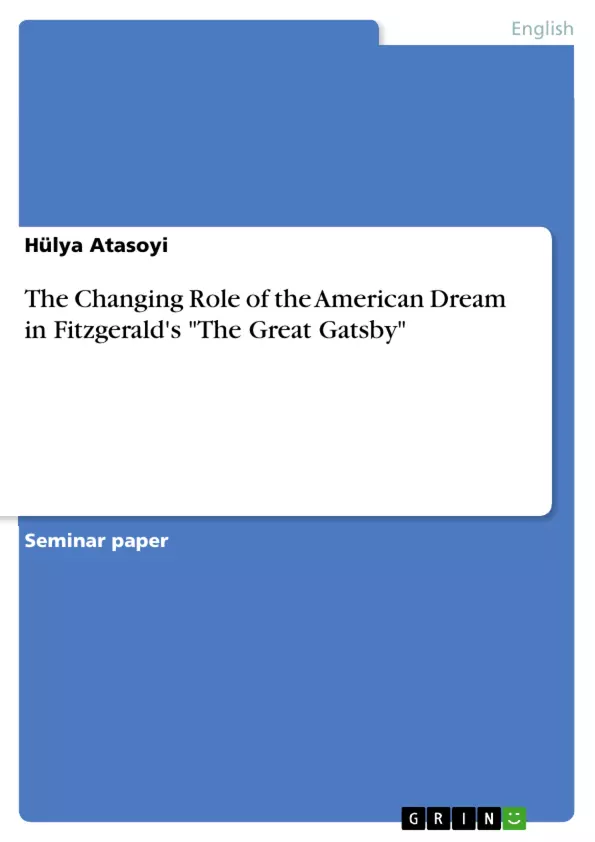This paper aims at providing an analysis of the American Dream with regard to F. Scott Fitzgerald’s novel "The Great Gatsby" from 1925. It will present an examination of whether the pursuit of happiness and freedom or the pursuit of success and wealth has a higher importance in the novel. By taking this issue into account, the change of the American Dream will be examined. Hence, each section will concentrate on the question whether the pursuit of happiness and freedom or the pursuit of success and wealth lead to a change in American society.
First of all, the general meaning as well as the idea and the values of the American Dream will be depicted; particularly, the American Dream as key concept for the understanding of American society will be discussed. Therefore, Fitzgerald’s most famous novel from 1925, is important to establish a connection between the values and the changing role of the American Dream in the literature of the United States of America. It will be examined whether the values of the American Dream changed and which aspects are to be considered when regarding these values. It might be significant to see how the American Dream is changing over the course of time. Afterwards, by presenting the dark side of the American Dream, this paper takes a specific look at the deconstruction of the American Dream in "The Great Gatsby". Due to this fact, the American Dream is turning into an American nightmare, which will also be investigated. What is also presented in this section is a criticism of the American Dream.
Finally, the question whether the pursuit of happiness and freedom or the pursuit of success and wealth plays a more important role will be answered. The changing role of the American Dream will also be clarified and briefly summarized.
Table of Contents
- Introduction
- Meaning of the American Dream
- The Idea and the Values of the American Dream
- The American Dream as a Key Concept in The Great Gatsby
- Did the Values of the American Dream Change?
- The Dark Side of the American Dream
- The Deconstruction of the American Dream in The Great Gatsby
- Criticism of the American Dream
- Conclusion
Objectives and Key Themes
This paper aims to analyze the American Dream in relation to F. Scott Fitzgerald's novel The Great Gatsby (1925), examining whether the pursuit of happiness and freedom or the pursuit of success and wealth is more important in the novel. It investigates the changing role of the American Dream by analyzing how the values and perception of the dream have evolved over time.
- The evolution of the American Dream and its different interpretations
- The importance of the American Dream as a key concept in understanding American society
- The role of the American Dream in shaping American literature
- The dark side of the American Dream and its deconstruction in The Great Gatsby
- The relationship between the American Dream and the pursuit of happiness, freedom, success, and wealth
Chapter Summaries
The introduction provides an overview of the paper's focus on the American Dream and its changing role, particularly in relation to F. Scott Fitzgerald's novel The Great Gatsby. It outlines the key questions and themes that will be explored throughout the paper, including the pursuit of happiness and freedom versus the pursuit of success and wealth.
Chapter 2 delves into the meaning of the American Dream, exploring its historical roots in the Declaration of Independence and tracing its evolution through various definitions offered by prominent thinkers like James Truslow Adams. The chapter examines the different interpretations of the dream, highlighting the tension between the pursuit of material prosperity and the pursuit of happiness.
Chapter 3 investigates the idea and values of the American Dream, focusing on its significance as a key concept in understanding American society. It examines the values that underpin the dream, including the importance of equality, opportunity, and individual achievement. The chapter further explores whether these values have changed over time and how they are reflected in Fitzgerald's The Great Gatsby.
Chapter 4 examines the dark side of the American Dream, highlighting its deconstruction and criticism in Fitzgerald's novel. It analyzes the social and economic realities that undermine the dream, demonstrating how it can lead to disillusionment and despair. This chapter also explores how the American Dream can be transformed into an American nightmare.
Keywords
This paper focuses on the American Dream, its evolution, and its representation in American literature, particularly in F. Scott Fitzgerald's novel The Great Gatsby. Key terms and concepts include the pursuit of happiness, freedom, success, wealth, social order, equality, opportunity, individual achievement, disillusionment, and the American nightmare.
- Quote paper
- Hülya Atasoyi (Author), 2014, The Changing Role of the American Dream in Fitzgerald's "The Great Gatsby", Munich, GRIN Verlag, https://www.grin.com/document/313279



